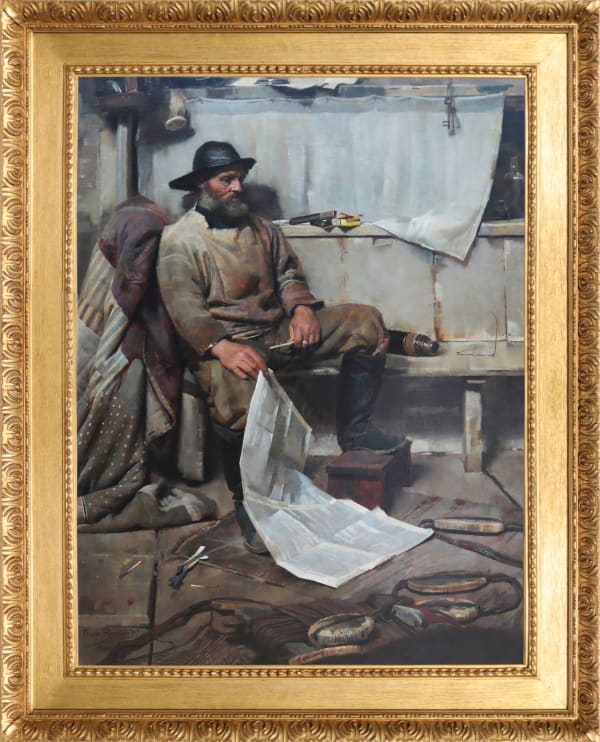Frank Richards 1863-1935
-
 Frank RichardsFisherman Reading, 1890Oil on canvas101.6 x 76.2 cm (40 x 30 ins)
Frank RichardsFisherman Reading, 1890Oil on canvas101.6 x 76.2 cm (40 x 30 ins)
Framed: 123.8 x 99.1 cm (48 3/4 x 39 ins)View full details -
 Frank RichardsLizard LighthouseOil on canvas67.5 x 87.8 cm (26.6 x 34.6 ins.)
Frank RichardsLizard LighthouseOil on canvas67.5 x 87.8 cm (26.6 x 34.6 ins.)
Framed: 101.0 x 121.9 cm (39.8 x 48 ins.)View full details -
 Frank RichardsEnd of the Day: Newlyn, 1891Oil on canvas30.6 cm x 40.7 cmSoldView full details
Frank RichardsEnd of the Day: Newlyn, 1891Oil on canvas30.6 cm x 40.7 cmSoldView full details
“… the colour of everything is decided fresh, pure and brilliant, according to the day, the sea and sky effects are charming, especially in the summer, when we get a good deal of Italian blue." Frank Richards describing Newlyn in The Studio, 1895.
Frank Richards was born in Birmingham in 1863. He studied art at the Birmingham School of Art and remained in Birmingham until 1883 when he travelled to Europe and North Africa developing his en plein-air style of painting.
Richards was elected as Associate of the Royal Birmingham Society of Artists in 1884 along with future Newlyn contemporaries, Edwin Harris and William Banks Fortescue. In 1885 he was living at an address in Lulworth, Dorset.
Richards had moved to Newlyn probably by 1889 and certainly by 1890. In the 1890 exhibition at Dowdeswells, Richards exhibited 6 Newlyn-based sketches and watercolours, including 'Sketch for Cornish Courtyard' and 'The Way to the Laundry-Newlyn'. 'A Fisherman Reading' is a significant Newlyn work in oils dated 1890 and 'End of the day, Newlyn' is dated 1891. Both works embrace the square brush technique of the French en plein-air movement adopted in the early years of the Newlyn School.
In an article for The Studio Vol 5 (1895) - 'Newlyn as a Sketching Ground', Richards wrote that he had been in and around Newlyn for five years and knew it under 'all its various changes and aspects, according to time of year and weather...'
In Newlyn Richards had joined the Birmingham pioneers of the Newlyn School, Walter Langley and Edwin Harris, and located himself within a colony of like-minded artists pursuing an en plein-air movement in Britain following their collective experiences in Europe. In The Studio article of 1895, the artist continued to describe some of the attractions of Newlyn for the en plein-air artist, "… the colour of everything is decided fresh, pure and brilliant, according to the day, the sea and sky effects are charming, especially in the summer, when we get a good deal of Italian blue".
Richards was a particularly strong proponent of the Newlyn square brush technique which utilised the flat of a square brush in order to lay the paint on the canvas in a weave of brush strokes that gave movement and vibrancy to the painted surface.
In 1894, Richards held a solo exhibition at Dowdeswell Gallery, London and was a regular exhibitor in St Ives and Newlyn, further contributing to the Newlyn School exhibitions at the Castle Galleries, Nottingham and Dowdeswell Gallery. The artist also exhibited at the Royal Academy, the Royal Society of British Artists, the Royal Institute of Oil Painters in London, the Royal Society of Artists in Birmingham, Walker Art Gallery in Liverpool and Manchester City Art Gallery.
Richards offers an interesting insight into the social life of the Newlyn Colony of artists and their friendly rivalry with their contemporaries a few miles away in St Ives. From 1886, annual cricket matches took place between the artists of the two schools and from his arrival in Newlyn, Richards played with teammates Forbes, Langley, Harris, Rheam, Chelvalier Tayler and Hall. Richards wrote of it “…. For lighter enjoyment on a hot summer’s day we indulge in cricket. Newlyn versus St Ives is the match of the year, generally terminating in a victory for the home team over the friendly opponents.”
In 1897, Richards moved back to London but 1902 saw him back in the West Country, this time Dorset, firstly in Wareham but by 1917 he was living in Bournemouth. He was elected a full member of the Royal Society of British Artists in 1921 and died in 1935 in Bournemouth, where a beautiful painting, “In a Cornish Orchard” resides in the Russell-Cotes Art Gallery and Museum.




